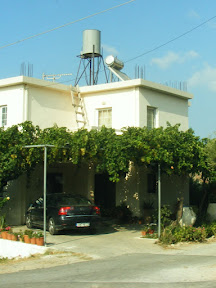I know that this blog is in no way a travel blog, but I just returned from a trip to Crete, and share some of my observations of that island.
Geography and Climate
Apart from some coastal plains that stretch not more than a mile inward, Crete is solid mountains. This makes for some pretty complicated road engineering to reach the little towns that seem flung throughout the hills.
Most communities are small, and spread across the island's many fields of olive trees and orange trees. Many of the coastal plains are full of greenhouses for tomatoes, cucumbers, and other veggies. The crop that "covers" the greatest part of the island is also one of the least noticeable: honey. Even in the rocky crags far above the habitat for trees, bees from apiaries seek out flowers from wild thyme and other high-altitude shrubs.
The soil is often rocky, but the farmers have one benefit from Crete: the weather is extraordinarily consistent. From December to March, it will rain about every second day. Otherwise, it is completely dry and for the most part sunny. Many farmers have cisterns that fill with water during the wet season.
Religious Buildings
In addition to churches and a few mosques and monasteries, two notable additions to religious structures in Crete are the ubiquitous chapels and shrines. The chapels are gathering places for 5-20 people, often in geographically interesting (i.e. cave) or remote (i.e. the top of an 860 m mountain) places. They're usually dedicated to a specific saint, and used just a couple times a year. Shrines look like miniature chapels and seem to be every couple km on every road on the whole island.
 |  |  | What is this? A center for ants? How can we be expected to teach children to learn how to read... if they can't even fit inside the building? |
Energy
Given Crete incredible amount of sun, it comes at no surprise that some forms of solar power are used. While I didn't see a single PV panel, almost every building had solar water heating, either in the form of a big black tub on its roof, or the standard
off-the-shelf heat pipe variety. It works so well that most places just have electric "backup" for hot water and rely mostly on the sun.
The other thing to notice in the left picture is all those metal rods sticking out of the roof. That's because this building isn't "finished". Oh sure, it's occupied and there's all that water infrastructure on the roof, but the owners are still "planning" to add another floor. The tax laws in Crete state that a building that is not "completed" is assessed at a lower value or subject to a lower rate (I'm not sure which). Either way, the taxes for an "unfinished" building are less. Therefore, it seemed like 3/4 of all 1-3 story residential buildings are "designed" to be one story higher, complete with extra-long reinforcing members, but then stopped for some reason "part way through".
One renewable electrical source being used is wind. I saw two wind farms on top of ridges and a third being built. The turbines probably have a pretty good capacity factor if the consistency of wind is anything like that for sun.
Ancient Crete
I stayed near ruins of the ancient city of
Falasarna, built in 335 BC. The city had a fortified harbor, and the rest of the buildings were built up a steep hill and protected by a stone wall. These defenses held up for 300 years, but were no match for the Roman fleet that destroyed the city after it became a haven for pirates.
But even without the Romans, Falasarna would not have remained a thriving port forever. You may have noticed that there doesn't actually seem to be that much water around these buildings. That is probably due to a
big earthquake that actually raised the land elevation 6 meters, bringing all the docking infrastructure high and dry. The left picture shows the long peninsula on which Falasarna was built. On the right, the dark lines on the distant cliff show the previous level of the water.
On the horizon in the left picture, you can just make out another land mass. This is the island
Antikythera, home to 44 people. Apart from being the 2nd least populous district in Greece, the island is most famous for a sunken ship that was found nearby. Scientists found on this ship the
Antikythera mechanism, that clock-like device that kept track of planetary movement
The device is remarkable for the level of miniaturization and for the complexity of its parts, which is comparable to that of 18th century clocks. It has over 30 gears. When a date was entered via a crank (now lost), the mechanism calculated the position of the Sun, Moon, or other astronomical information such as the location of other planets. Since the purpose was to position astronomical bodies with respect to the celestial sphere, with reference to the observer's position on the surface of the earth, the device was based on the geocentric model.
As Wikipedia says, the mechanism is many centuries ahead of its time. Therefore, many people, such as Erich von Daniken, have claimed that it's proof of alien interactions. The device was clearly a navigational instrument used in alien spaceships, which "tells us how little we know about the wisdom which the gods whispered into the ears of their darlings".












